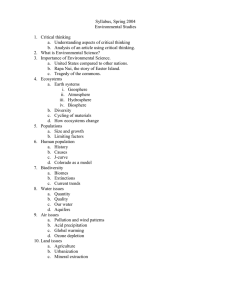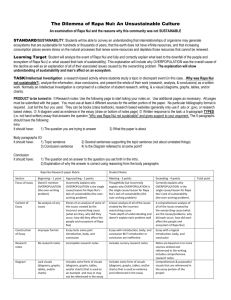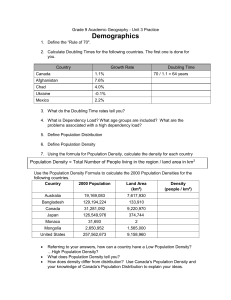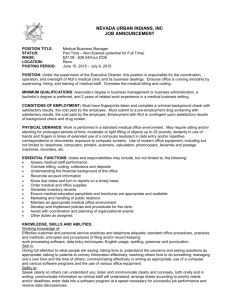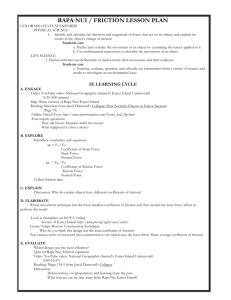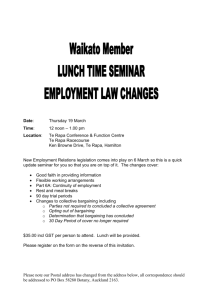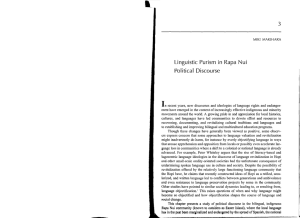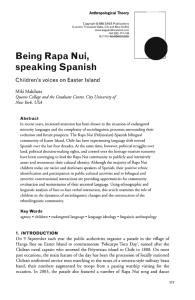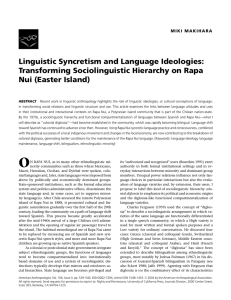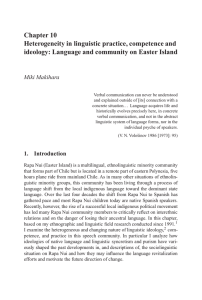Document 11143729
advertisement
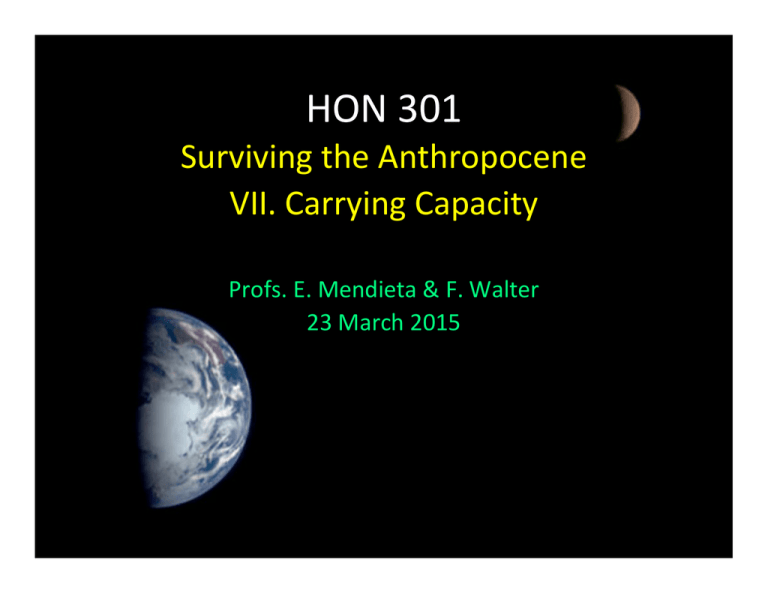
HON 301 Surviving the Anthropocene VII. Carrying Capacity Profs. E. Mendieta & F. Walter 23 March 2015 Carrying Capacity • In equilibrium, the birth rate = the death rate • The human populaNon is not in equilibrium • The human populaNon growth is > 1%/yr • This growth rate is unsustainable Survival of Species? The typical species survives about 106 years • Species go exNnct, or evolve Species that survive longer tend to be • Adaptable • Not too specialized • moNle Invasive Species • Transported to new ecosystem • Out of equilibrium with the ecosystem – Some fail to thrive – Some thrive in absence of natural prey • If the invasion is small, the ecosystem can rebalance • If not, a new balance is struck Examples of Invasive Species • • • • • • • • • • Rabbits and foxes in Australia Kudzu in southeastern US Pythons in Florida Zebra Mussels in Great Lakes Brown tree snake (Guam) Common Carp (freshwater lakes) Rats (almost everywhere) Dutch Elm Disease (US) Gypsy Moth (NE US) Fire Ants (Texas) Humans as an Invasive Species • Homo Heidelbergensis ~ 1.8 Mya • Homo Sapiens “Out of Africa” ~ 75,000 ya • Technology permiged adaptaNon to wide range of climates • Populated enNre Old World by ~30,000 ya • Populated enNre New World by ~15,000 ya • Populated Polynesia by 900 CE Humans as an Invasive Facilitator Carried useful and not-­‐so-­‐useful species • Beasts of burden • Cagle • Edible plants • Rats • Human parasites Humans as an Invasive Species Two effects: • Direct impact on the environment • Indirect impact on the environment Example of Direct Impact: ExNncNon of Large Mammals • Large animals have few natural enemies • Most large animals have a reproducNon strategy of few young infrequently • HunNng, combined with environmental stresses, can explain exNncNon of large mammals ~ 10,000 years ago Did not occur in Africa Indirect Impact: Removal of geographic barriers Increase in invasive species from: • Rapid interconNnental travel • Trade in exoNc species ExNncNon leads to drops in bio-­‐diversity Carrying Capacity The maximum number of human beings the planet can support. We need resources, including: • Water • Food • Energy • Raw materials for manufacturing Food Resources • Wild • DomesNcated – Plants – Animals Sustainability depends on • PopulaNon pressure • Climate change Energy Resources • Renewable – BioNc • Animals (e.g., beasts of burden) • CombusNon of plant materials • Animal oils – AbioNc • Solar • Hydro • Wind • Non-­‐renewable – Petroleum (oil/gas) • Peak oil – Nuclear Peak Oil Raw Materials • Renewable (bioNc) – Plant products (e.g., wood) – Animal products (e.g., bone, sinew) • Non-­‐renewable – ores Anaconda mine, Buge MT Fresh Water • Renewable – PrecipitaNon runoff • Non-­‐renewable – Aquifers • DesalinizaNon of seawater Ogallala Aquifer Contains ~3.3x109 acre-­‐feet Typically 112 feet deep 6000 years to recharge Over 11% depleted by 2009; current rate ~ 2%/yr) Ground Water DepleNon Some Numbers • • • • • • Surface area of Earth: 5.10 x 1014 m2 Land Area: 1.49 x 1014 m2 = 1.49 x 1010 ha Current number of humans: 7.3 x109 Area/person: 2.04 ha Arable land: ~ 4.2 x 109 ha Arable land (in use)/person: ~0.25 ha => ~ half of potenNally arable land is in use It takes about 1 acre (0.45 ha) to feed an American (hgp://www.farmlandlp.com) OverpopulaNon Earth has a finite carrying capacity • We need sufficient – Fresh water – Food • We need space for plants and animals Carrying Capacity is unknown • EsNmates range 4 -­‐ 16 billion Human PopulaNon Growth Why the PopulaNon is Growing hgp://www.eoearth.org/view/arNcle/153596/ How Long Un5l the Earth is Full? ExponenNal Growth • Y=tX, X>1 The Meaning of ExponenNal Growth • A constant percentage increase per Nme • e.g, a 2% populaNon growth is exponenNal. • The doubling Nme is 70/ the percentage growth (70 ~ 100 ln(2) = 69.3) The Meaning of ExponenNal Growth Consider a test tube with one bacterium. • The size of a bacterium is ~1 μm (10-­‐4 cm) • Volume of the bacterium ~ 10-­‐12 cm3 • The bacterium divides every 30 minutes. • The volume of the test tube is 40 cm3. • You can fit 4x1013 bacteria in the test tube How long unNl the test tube is full? The Meaning of ExponenNal Growth • • • • • • Doubling Nme is 30 minutes % growth = 70/30 =2.3% per minute There is room for 40/10-­‐12 = 4 x 1013 bacteria in the test tube. When is the test tube full of bacteria? Aser ln(3 x 1013)/ln(2) doubling Nmes Aser 44 doubling Nmes, there are 2x1013 bacteria • In another 30 minutes the test tube is full. • That’s 22.5 hours! The Meaning of ExponenNal Growth • There are now 7.3 billion people on Earth • PopulaNon growth is about 1.14% per year • The surface area of Earth is about 5x1014 m2 • About 29% of the Earth is land. • Each person has, in principle, about 20,000 sq m The Meaning of ExponenNal Growth • Define the Earth as full when each person has 1 sq m. • That requires 20,000 Nmes the present populaNon, or about 1014 people on Earth. • Current doubling Nme is 70/1.14 = 61 years • At the current rate, that will take 14 doubling Nmes, or 840 years! The Meaning of ExponenNal Growth Suppose we cap Earth at its current populaNon, and start colonizing extrasolar planets. • Assume one Earth-­‐like planet per star • We fill the galaxy (4x1011 stars) in 36 doubling Nmes. That’s only 2200 years! In the space of one hundred and seventy-­‐six years the Lower Mississippi has shortened itself two hundred and forty-­‐two miles. That is an average of a trifle over one mile and a third per year. Therefore, any calm person, who is not blind or idioNc, can see that in the Old Silurian Period, just a million years ago next November, the Lower Mississippi River was upwards of one million three hundred thousand miles long, and stuck out over the Gulf of Mexico like a fishing rod. And by the same token any person can see that seven hundred and forty-­‐two years from now the Lower Mississippi will be only a mile and three quarters long, and Cairo and New Orleans will have joined their streets together, and be plodding comfortably along under a single mayor and a mutual board of aldermen. There is something fascina5ng about science. One gets such wholesale returns of conjecture out of such a trifling investment of fact. Life on the Mississippi, by Mark Twain Malthusian Theory Famine seems to be the last, the most dreadful resource of nature. The power of popula=on is so superior to the power of the earth to produce subsistence for man, that premature death must in some shape or other visit the human race. Malthus ,T.R. 1798. An essay on the principle of popula=on. Chapter VII, p61 Malthusian Theory. I. • PopulaNon increases exponenNally • Food producNon does not • At some point, we’ll have too ligle food, and something will have to give. • This applies to fresh water and other limited resources too Malthusian Theory. II. So far: • PopulaNon growth has decreased • The “Green RevoluNon” has kept pace with populaNon growth Necessity is the Mother of Inven=on Long Term Survival of a CivilizaNon Based in part on Collapse, by Jared Diamond Influences on Survival 1. 2. 3. 4. 5. Self-­‐inflicted ecological damage Climate change HosNle neighbors Friendly neighbors (trade) Response to problems Examples • • • • • • • Rome Easter Island (Rapa Nui) Mesopotamia Anasazi Maya Greenland/Iceland Tikopia Rapa Nui • 16,000 ha • Segled ~ 700-­‐1100 CE • Temperate climate; poor soil Rapa Nui 16,000 ha Segled ~ 700-­‐1100 CE Temperate climate; poor soil Originally forested, including largest known palm trees • PopulaNon peaked @~15,000 ~1500 CE • • • • Rapa Nui 16,000 ha Segled ~ 700-­‐1100 CE Temperate climate; poor soil Originally forested, including largest known palm trees • PopulaNon peaked @~15,000 ~1500 CE • • • • • By 1770, populaNon 1,000-­‐2,000 • No trees Rapa Nui The Story: All was well for ~500 years. But… • Humans introduced rats to Rapa Nui • Too distant for regular human contact • Trees lost to – HarvesNng by humans harvested – and/or – – PredaNon by rats • No trees -­‐> no boats; no fishing • DeforestaNon leads to rapid collapse • Inferences from the moai? Rapa Nui Causes of the collapse? 1. 2. 3. 4. 5. Self-­‐inflicted ecological damage YES Climate change unknown HosNle neighbors NO Friendly neighbors (trade) YES Response to problems YES Tikopia • 500 ha • Segled ~ 1000 BCE Tikopia • 500 ha • Segled ~ 1000 BCE • PopulaNon stable at ~1200 through populaNon control • ~1600 CE: all pigs slaughtered; diet changed • ~1900 CE: ChrisNan missionaries outlaw birth control/aborNon; populaNon increased 50% • Now: emigraNon keeps populaNon stable • 3000 years of stability Tikopia Reasons for avoiding the collapse? 1. 2. 3. 4. 5. Self-­‐inflicted ecological damage YES Climate change unknown HosNle neighbors NO Friendly neighbors (trade) NO Response to problems YES Pressure relieved by populaNon control Responses to Crises • • • • • • • Ignorance Reasoning by False Analogy Creeping Normalcy Local Amnesia RaNonal Behavior Tragedy of the Commons IrraNonal Behavior Relevance to Earth Earth is a closed environment with finite resources. 1. Self-­‐inflicted ecological damage? YES 2. Climate change it happens 3. HosNle neighbors NO 4. Friendly neighbors (trade) NO 5. Response to problems TBD Steffen, W. et al. 2015 Science 13 February 2015: Vol. 347 no. 6223
